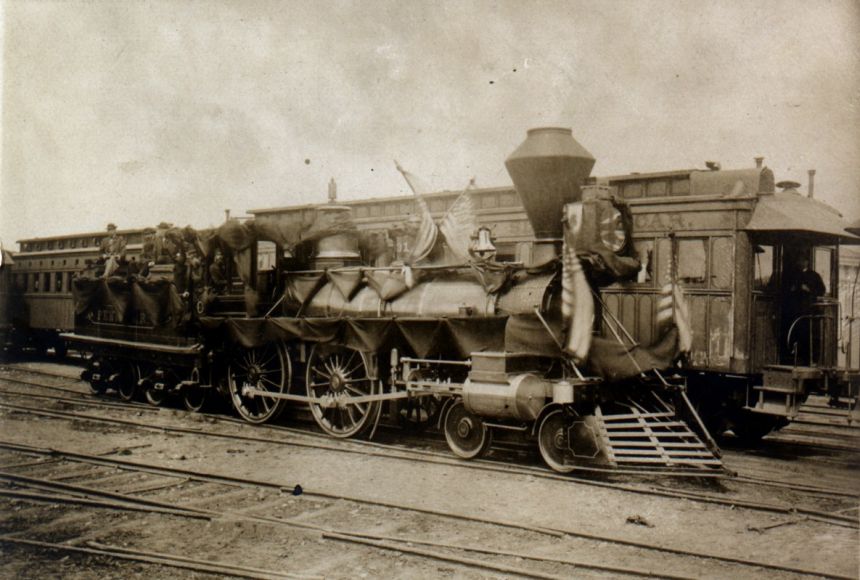On April 21, 1865, a train carrying a coffin pulled out of Washington, D.C. The train was bringing United States President Abraham Lincoln's body to be buried. In 2015, I retraced its route to Springfield, Illinois, to write this article.
Early on in my journey, I found a railroad spike in the weeds along the tracks. I knew it was probably only a few decades old, but still I picked it up and kept it. I liked its look, both industrial and homemade, rough and with sharp angles. It reminded me of Lincoln, the United States' great "railroad president."
In a sense, Lincoln and the new technology grew up together. The 1830s marked the first decade of major U.S. railroad construction. Lincoln was a 27-year-old state legislator and was pushing for the construction of new train lines. He later served as a lawyer for several railroad companies.
In 1861, when he went to Washington for his first inauguration, Lincoln journeyed by rail. He rode through the midwestern and northern states on a train. He journeyed farther to reach the White House than any president-elect before.
Since Lincoln's election in November 1860, seven southern states had already left the Union to form the Confederacy. Along his train trip, Lincoln made speeches to reassure his fellow Americans that the nation would be saved.
But the trip itself was a statement of union. The United States already had about 48,280 kilometers (30,000 miles) of track. It was a sign of the factories that helped the North leap ahead of the South. It was also a sign of the plans to build a line joining Atlantic to Pacific.
Four years later, the funeral trip was designed to make people remember his earlier journey.
Enslaved People Rode Train To Freedom
During the second day, the funeral train crossed from Maryland to Pennsylvania. More than 150 years ago, that was the border between North and South. Slaves rode to freedom on those tracks. During the Civil War, trains carried wounded soldiers.
Part of that track still survives and was recently repaired. A copy of an 1860s train travels along 16.1 kilometers (10 miles) of the track. I rode aboard the locomotive and thought of how new it must have seemed 150 years ago.
On my journey, we chuffed through the Pennsylvania fields. We passed an old man with a hoe in a vegetable patch and children waved at us. A teenager held up his iPad to record video.
On the 1865 trip, two train cars made the entire journey. One of the cars carried officers and members of the Lincoln family. The other was the funeral car itself and was named the United States. The car had actually been designed to carry Lincoln when he was alive. He rode in it only after death.
The car was built as the president's office on wheels and was finished in February 1865. For the funeral trip, it was draped in heavy black cloth with silver fringe. The car also carried the body of Willie Lincoln, the third son of President Lincoln and Mary Todd Lincoln. He had died in Washington in 1862 when he was 11 years old. His body was going to be reburied alongside his father.
The train passed through towns and villages, usually in darkness. As it passed, people kneeled by the side of the tracks reciting prayers and hymns.
Telegraph Lines near Tracks Brought News of the War
Ordinary Americans felt connected with Lincoln. Like him, they had suffered through four years of war. Soldiers left from train stations to go to war. Many people saw sons and brothers there for the last time. It was there that civilians brought the bandage, clothing, food, and flags for the war effort and the first news of battles arrived, brought by the telegraph lines that ran along the tracks.
Now, most of the trains have disappeared, replaced by highways. Many old villages grew up around rural stations, and they are now disappearing, as the trains have stopped.
In Elgin, Illinois, I met David Kloke. He was the master mechanic who built the replica of the Lincoln locomotive and was now completing a copy of the funeral car. Kloke had studied old photographs of the car and tracked down fragments of its wooden trim. "It's going to be beautiful," he said. It would be a dark red, almost chocolate color, with gold.
On May 2, 2015, Kloke's United States car was in Springfield to reenact Lincoln's funeral. An empty coffin was unloaded from the train onto a horse-drawn wagon and was driven to the old Illinois State House. It was taken to Oak Ridge Cemetery the next day.

